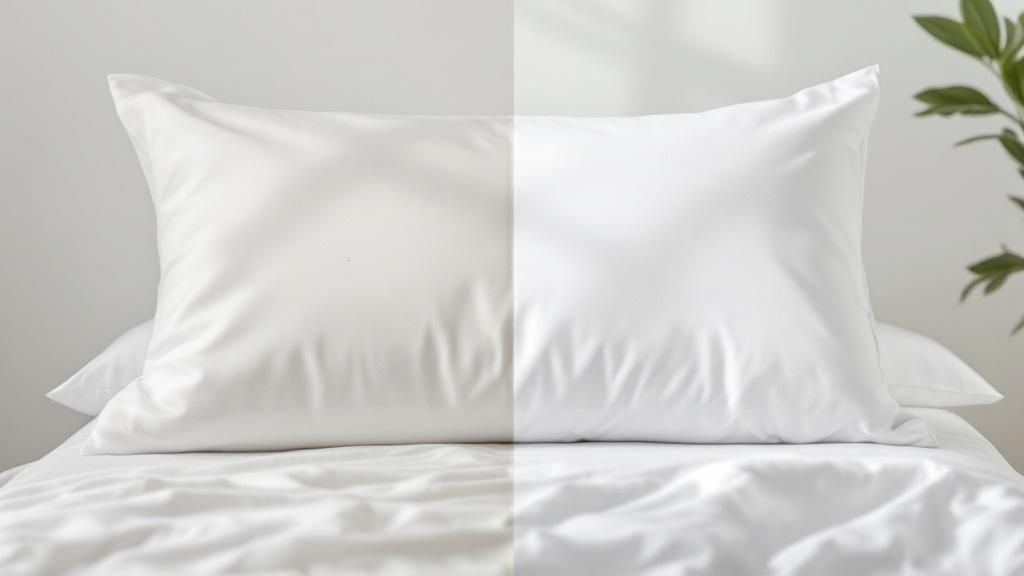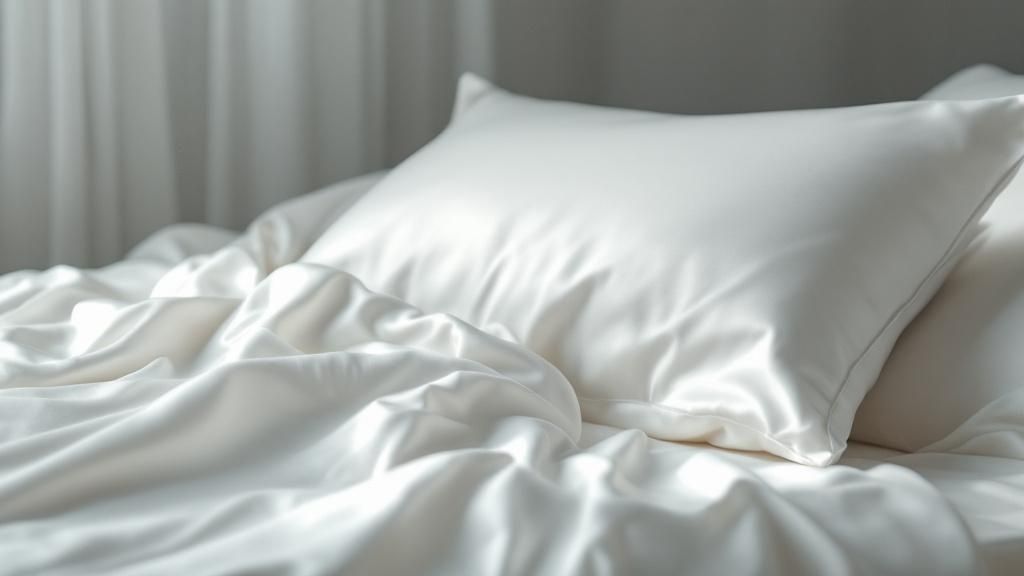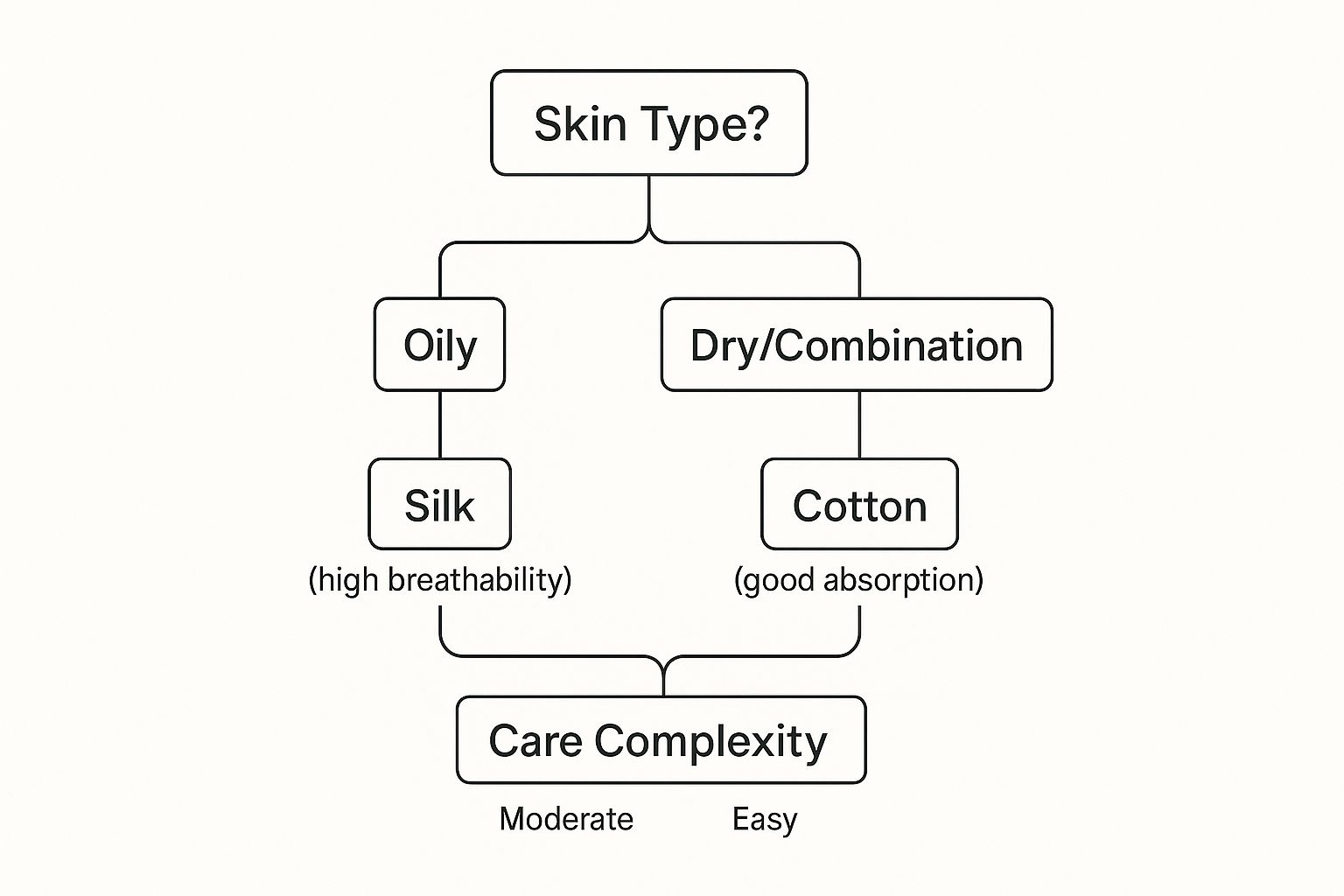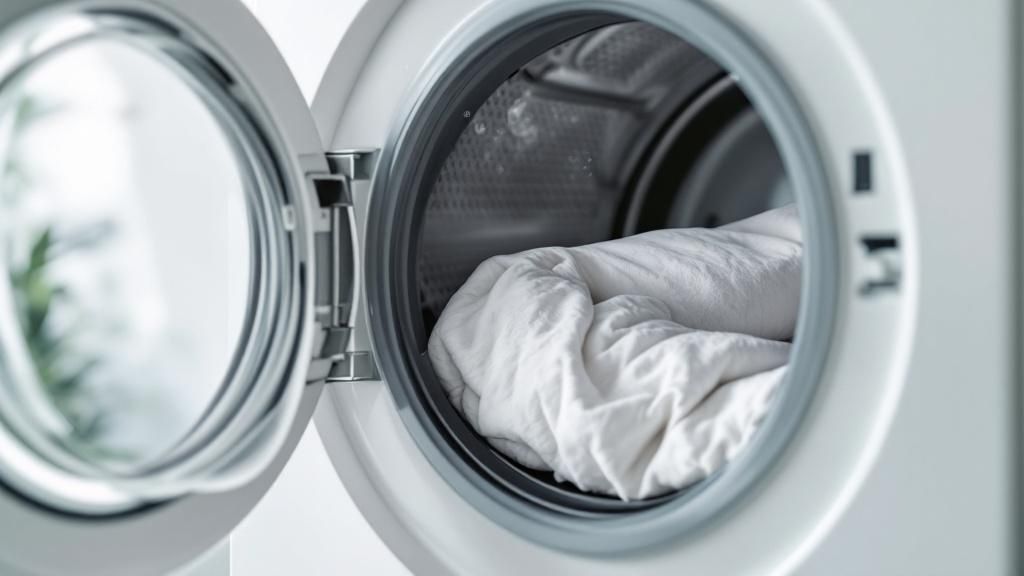When it comes to finding the right pillowcase for acne-prone skin, silk usually gets all the attention. It's famous for its smooth feel and the fact that it doesn't soak up everything it touches. But these days, innovative fabrics like bamboo and even silver-infused materials are giving silk a run for its money.
Figuring out how your pillowcase affects your skin is the first real step to making a better choice for your nightly routine.
How Your Pillowcase Could Be Sabotaging Your Skin
It’s easy to overlook, but that surface you press your face against for eight hours a night might be one of the biggest culprits in your fight for clear skin. Think of it this way: your pillowcase can undo all the hard work of your skincare routine. It's a nightly battleground where friction, absorption, and bacteria are working against you.
Rougher fabrics, especially traditional cotton, create friction every time you toss and turn. This constant rubbing can physically irritate sensitive skin, causing redness and inflammation that makes existing breakouts even worse. If you have tender, inflamed blemishes, this nightly irritation is a major problem.
The Hidden Issue with Absorbent Fabrics
Beyond friction, absorbency is another huge factor. Materials like cotton are incredibly absorbent, acting like a sponge for your skin's natural moisture and, yes, your expensive skincare products. Instead of that pricey night cream working its magic on your skin, it's getting soaked right into your pillow.
This creates a two-fold problem:
- Wasted Products: Your carefully applied serums and moisturizers just aren't as effective.
- More Oil: By stripping away natural oils, the fabric can actually signal your skin to produce more oil to compensate, leading to even more clogged pores.
Night after night, your pillowcase becomes a collection site for sweat, oil, dead skin cells, and bacteria. This buildup creates the perfect breeding ground for contaminants that get transferred right back to your face, keeping the acne cycle going.
This is why a material's ability to reduce friction and irritation is so important. Silk's incredibly smooth surface lets your skin glide across it, which is a huge help for avoiding aggravating inflamed acne. Plus, because silk is far less absorbent than cotton, it helps your skin hold onto its moisture and allows your skincare products to actually do their job. Experts at the Sleep Foundation explain these benefits in detail.
Choosing the right material isn't just a small upgrade; it turns your pillowcase from a problem into a true partner for healthier skin.
Pillowcase Material Comparison for Acne-Prone Skin
To make the choice a bit clearer, here’s a quick look at how different pillowcase materials stack up against each other based on what matters most for managing acne.
| Material | Friction Level | Absorbency | Breathability | Best For |
|---|---|---|---|---|
| Silk | Very Low | Low | Moderate | Reducing friction and preserving skin moisture. |
| Satin | Low | Low | Low | A budget-friendly alternative to silk for a smooth surface. |
| Cotton | High | High | High | General use, but not ideal for sensitive or acne-prone skin. |
| Bamboo | Low | Low-Moderate | Very High | Hot sleepers who need a breathable, soft, and hypoallergenic surface. |
| Silver-Infused | Low | Low | Moderate | Actively fighting bacteria and keeping the pillowcase cleaner for longer. |
This table shows there’s no single "perfect" material for everyone. While silk is a fantastic all-rounder for sensitive skin, someone who sleeps hot might prefer the superior breathability of bamboo. It all comes down to pinpointing your specific skin concerns and sleep habits.
Comparing the Top Fabric Contenders

When you're trying to find the right pillowcase to help with acne, the conversation almost always boils down to three materials: silk, bamboo, and cotton. They each have their own pros and cons, and knowing the real-world differences is what will help you pick the best one for your skin.
Let's break down how they really compare in the fight for a clearer complexion.
The Luxe Choice: Silk
There's a reason silk is often treated as the holy grail for skin-friendly bedding. It's incredibly smooth. That silky glide means less friction against your face as you toss and turn at night. For anyone dealing with sensitive, inflamed, or painful acne, reducing that physical irritation is a massive win.
What’s more, silk is a protein-based fiber that’s not very absorbent. This is a huge deal. It means your expensive night creams and the natural oils your skin produces stay on your face, where they belong, instead of getting sucked up by your pillowcase.
The Breathable Contender: Bamboo
Bamboo has quickly become a serious competitor to silk, and it’s a lifesaver for anyone who gets hot or sweaty at night. Bamboo fabric, which comes from bamboo viscose, is exceptionally soft—many people say it feels like a high-quality silk-cotton blend. Its biggest advantage, though, is its fantastic breathability and moisture-wicking power.
Bamboo actively pulls sweat away from your skin, keeping your face cooler and drier all night long. A dry pillowcase is a much less friendly place for bacteria to hang out. You can learn more about how bamboo pillowcases can improve your sleep hygiene and see why it’s a great choice for hot sleepers who still need a gentle touch.
Key Takeaway: Both silk and bamboo offer smooth surfaces that are kind to acne-prone skin, but your sleep style is the tie-breaker. If friction is your biggest enemy, silk is unmatched. If you run hot and need a cool, dry night's sleep, bamboo's breathability is a game-changer.
The Common Staple: Cotton
And then there's cotton. We all have it. It's affordable, it's durable, and it's everywhere. But for those of us with acne-prone skin, it comes with some serious downsides.
First, the fibers are naturally rougher than silk or bamboo, creating more friction that can easily irritate existing breakouts. Second, cotton is extremely absorbent. Think of it like a sponge for sweat, facial oils, and skincare products. Night after night, it just soaks everything up, creating a breeding ground for pore-clogging gunk. Even a high-thread-count sateen cotton, while it feels smoother, doesn't change this core absorbent quality, making it a poor choice if clear skin is your goal.
A New Wave: Antimicrobial and Silver-Infused Fabrics
While materials like silk and cotton have long been staples, a new generation of bedding is emerging that takes a more active role in skincare. These are fabrics with built-in antimicrobial properties, designed to fight the very bacteria that can lead to breakouts.
Think of it as a proactive defense for your skin. These advanced pillowcases are engineered with agents that are woven right into the threads, creating a material that actively inhibits bacterial growth. It's a smart way to keep your sleep surface cleaner between washes.
The Science Behind Silver-Infused Pillowcases
So, how does it actually work? One of the most popular methods involves using silver. Tiny silver ions are infused directly into the fabric's fibers. These ions are naturally antibacterial, working to disrupt and neutralize bacteria cells on contact.
This process essentially stops bacteria from multiplying and transferring to your face while you sleep. While these pillowcases are a fantastic addition to a good skincare routine, it's helpful to see them as a powerful tool, not a magic cure. If you're curious about other naturally hygienic materials, you might also be interested in exploring the antibacterial benefits of bamboo sheets, which offer similar perks.
A Quick Note on Longevity: The powerful antimicrobial effect isn't meant to last forever. Proper care is essential, as the special properties can fade with repeated washing over time.
This technology is a big step forward for anyone looking for the best pillowcase material for acne. According to reports from sources like Refinery29, some silver-ion pillowcases maintain their antimicrobial strength for about 18 washes before their effectiveness begins to wane. Always follow the care instructions to make sure you get the most out of your investment and keep the fabric working for your skin.
Pillowcase Hygiene Habits for Clearer Skin

Picking the right pillowcase material is a fantastic first step, but let's be honest—even the best fabric is useless if it’s dirty. If you're serious about fighting acne, your hygiene habits are just as important as the pillowcase itself. A clean pillowcase is your best friend; a dirty one can sabotage all your skincare efforts.
Think about it: every night, your pillowcase collects a gnarly mix of facial oils, dead skin cells, and bacteria. This buildup is a recipe for clogged pores and fresh irritation. That’s why setting up and sticking to a washing routine is completely non-negotiable.
Your Washing and Care Checklist
The trick is to clean your pillowcase effectively without destroying the fabric and its skin-friendly properties. Different materials need different care, so you can't just toss everything in on a hot wash and hope for the best.
Here's what I've found works wonders:
- Set a Schedule: Make a point to wash or change your pillowcase at least twice a week. If you have very oily skin or slather on thick night creams, you might even want to swap it out every other day.
- Pick the Right Detergent: This is crucial. Always, always use a fragrance-free, hypoallergenic detergent. The perfumes and harsh chemicals in standard detergents can leave a residue that irritates sensitive skin and undoes all your hard work.
- Mind the Material: Delicate fabrics like silk or specially treated antimicrobial materials require a gentle touch to stay effective. For example, knowing how to care for your bamboo sheets and pillowcases properly will keep them soft and working for your skin, not against it.
Dermatologists constantly remind us that clean bedding is a cornerstone of any good acne management plan. A 2023 advisory highlighted just how vital frequent pillowcase changes are for preventing the buildup of bacteria and oil. If you want to dive deeper into the science, you can discover more insights about pillowcase hygiene from Acne.org to see why this simple habit packs such a powerful punch for skin health.
Choosing the Right Pillowcase for Your Skin and Budget
Alright, you've got the rundown on all the different fabrics. Now comes the part where you make a decision that actually works for you—your skin, your lifestyle, and your wallet. This isn't about just grabbing the priciest pillowcase and hoping for the best. It's about making a smart, personal choice that can genuinely move the needle in your skincare routine.
Think about your specific situation. If you're dealing with really angry, painful breakouts, the smooth glide of a silk pillowcase can be a godsend. It offers the least friction, which means less irritation for your already sensitive skin. But if you're someone who wakes up sweaty or just runs hot, the impressive breathability and moisture-wicking power of bamboo might be the key to keeping your skin cool, dry, and happy all night long.
Matching Your Needs with Your Wallet
Ultimately, this all comes down to a classic balancing act: benefits versus budget. Yes, a top-tier silver-infused or high-momme silk pillowcase is an investment upfront. But when you think about the money you might be spending on skincare products that aren't working as well as they could because of your bedding, the long-term value starts to make a lot of sense.
This chart breaks it down even further, connecting common skin issues with the best material and its maintenance needs.

As the visual points out, something like silk is great for oily skin because it doesn't trap heat and moisture. On the other hand, cotton might work for some, but you have to be extra diligent about washing it.
To help you decide, here’s a quick-glance table. It’s designed to help you pinpoint the best option based on what you’re trying to solve.
Decision Guide: Which Pillowcase Is Right for You?
| Primary Concern | Top Recommendation | Budget-Friendly Alternative | Key Benefit |
|---|---|---|---|
| Inflamed, Sensitive Acne | Silk (22-momme or higher) | Bamboo | Lowest friction; prevents irritation |
| Oily Skin & Night Sweats | Bamboo | Silver-Infused Cotton | Moisture-wicking; keeps skin dry |
| Persistent Breakouts | Silver-Infused Fabric | Copper-Infused Fabric | Antimicrobial; fights bacteria buildup |
| General Prevention / Budget | Microfiber | High-Quality Cotton (Sateen) | Easy care & good performance for the price |
Choosing the right pillowcase isn’t just a purchase; it's a strategic part of your skincare. By aligning your choice with your skin's unique behavior and your budget, you create a sleep environment that supports your goal of a clearer complexion.
Think of your pillowcase as a nightly tool in your skincare arsenal. Choosing one that fits your skin's behavior, lifestyle, and financial comfort is the final, crucial step to creating a sleep environment that actively promotes a clearer complexion. A thoughtful choice here empowers your entire routine.
Answering Your Top Pillowcase Questions

Even after diving into different fabrics and washing schedules, it's natural to have a few questions left. Let's clear up some of the most common ones so you can choose your next pillowcase with confidence.
A big one I hear all the time is, "Will I see results overnight?" While switching to a skin-friendly pillowcase is a fantastic step, think of it as playing the long game. You're creating a consistently cleaner, healthier environment for your face every single night, which boosts the efforts of your entire skincare routine over time.
Silk vs. Satin: What's the Real Difference?
It’s incredibly easy to mix these two up, but when it comes to your skin, the distinction matters. Silk is a natural protein fiber known for being incredibly smooth, breathable, and hypoallergenic. It's an actual, natural material.
Satin, on the other hand, isn't a material at all—it’s a type of weave. Satin pillowcases are usually made from synthetic fabrics like polyester or nylon. While they might feel slippery and look shiny like silk, they just don't have the same benefits. Synthetics can trap heat and moisture, which is the last thing you want if you're prone to breakouts.
My Advice: Always check the label. If you're looking for the best pillowcase material for acne, you want a true fabric like 100% silk or bamboo, not just a satin weave.
The Pillow-Flipping "Hack": Does It Work?
We’ve all done it. You’re tired, and flipping the pillow over to the "clean" side feels like a clever shortcut. But is it really helping?
Honestly, not as much as you'd think. The underside of your pillowcase has likely been absorbing the oils, sweat, and hair products that seep through from the top. Flipping it might buy you one more night, but it's far from a real solution. Nothing beats the effectiveness of washing your pillowcase regularly to give your skin a genuinely fresh surface.
Ready to give your skin the clean, cool, and gentle surface it deserves? The Bamtek 100% organic bamboo pillowcases offer a hypoallergenic, thermoregulating, and incredibly soft experience, perfect for supporting clearer skin. Explore our collection today!










